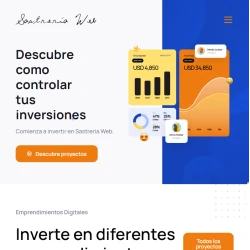
Crowdfunding
Often, traditional sources such as bank loans or angel investors are not available or suitable for all entrepreneurs. This is where crowdfunding comes into play, an option that has gained popularity in recent years. However, instead of turning to public platforms, many entrepreneurs are choosing to create their own private crowdfunding platforms. In this article, we will explore how you can use this strategy to finance your digital or entrepreneurial projects.
What is a Private Crowdfunding Platform?
A private crowdfunding platform is a website or application designed specifically to raise funds for projects or companies in an exclusive and controlled manner. Unlike public platforms like Kickstarter or GoFundMe, a private platform allows you to have complete control over who can participate, how projects are presented, and how funds are distributed.
Advantages of Creating Your Own Private Crowdfunding Platform
1. Total Control over your Project
By having your own platform, you can establish the rules of the game. This includes setting funding goals, controlling campaign visibility, and choosing who can contribute.
2. Greater Participation of your Community
A private platform allows your followers, clients or community members to have a closer and personal participation in the success of your project. This can strengthen relationships and generate deeper loyalty to your brand.
3. Customization and Flexibility
You can customize the design, structure and functionalities of the platform so that they align perfectly with the identity of your project or company. Additionally, you have the flexibility to experiment with different funding models, such as donations, rewards, equity, etc.
4. Privacy and Security
A private platform offers you a more secure and controlled environment to manage transactions and user information, which is crucial to protect your funders' sensitive data.
Steps to Create a Private Crowdfunding Platform
1. Define the Objectives and the Crowdfunding Model
Before starting, it is essential that you clearly define the objectives of your crowdfunding campaign and the model you will use (donations, rewards, capital, etc.). This will help you structure the platform in a way that suits the needs of your project.
2. Choosing the Right Technology
There are several tools and software platforms that allow you to create a custom crowdfunding website. Some popular options include WordPress with crowdfunding-specific plugins, SaaS platforms like FundRazr, or even developing a custom solution.
3. Design the User Experience
Design and usability are crucial to the success of a crowdfunding platform. Make sure navigation is simple, information is clear, and users can make contributions quickly and securely.
4. Establish Secure Payment Methods
Implement payment methods that are secure and convenient for your users. This can include options like PayPal, Stripe, bank transfers, or even cryptocurrencies, depending on your audience.
5. Launch the Campaign and Promote your Platform
Once your platform is ready, it's time to launch the campaign and start promoting it. Use digital marketing strategies such as SEO, content marketing, social media, and email to attract potential funders.
6. Monitor and Adapt
During the campaign, monitor the performance of your platform and make adjustments as necessary. This may include improving user experience, optimizing campaign pages, or adjusting funding goals.
Examples of Success
There are numerous examples of entrepreneurs who have used private crowdfunding platforms to finance successful projects. From technology startups to creative projects, this approach has allowed many companies to achieve their financing goals in an efficient and personalized way.
Creating a private crowdfunding platform can be a powerful strategy to finance your digital or entrepreneurial projects. By offering a controlled and personalized environment, you can not only achieve your funding goals, but also strengthen your relationship with your community and maintain full control over your project. With proper planning and implementing the right tools, you can bring your ideas to life and take your business to the next level.

